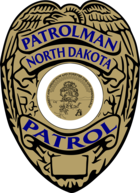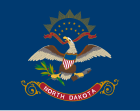North Dakota Highway Patrol
| North Dakota Highway Patrol | |
|---|---|
 Patch of North Dakota Highway Patrol | |
 Seal of North Dakota Highway Patrol | |
 Badge of North Dakota Highway Patrol | |
 Flag of North Dakota | |
| Abbreviation | NDHP |
| Agency overview | |
| Formed | 1935 |
| Employees | 197 (as of 2021) [1] |
| Annual budget | $63,811,414 Million USD [2] |
| Jurisdictional structure | |
| Operations jurisdiction | North Dakota, USA |
| Size | 70,762 square miles (183,270 km2) |
| Population | 779,094 (2020 est.)[3] |
| Legal jurisdiction | |
| General nature | |
| Operational structure | |
| Headquarters | Bismarck, North Dakota |
| Troopers | 159 (authorized, as of 2022) [4] |
| Civilians | 40 (as of 2021) [5] |
| Elected officer responsible | |
| Agency executive |
|
| Parent agency | North Dakota State Cabinet |
| Regions | 4 |
| Facilities | |
| Aircraft | Cessna 206 DJI Matrice 300 RTK |
| Website | |
| NDHP Website | |
The North Dakota Highway Patrol, also known as the North Dakota State Patrol, is the state police and highway patrol agency for North Dakota, with jurisdiction over the entire state. It is a division of the North Dakota State Cabinet. Colonel Daniel J. Haugen has been serving as the 18th superintendent since December 15, 2024.
North Dakota Highway Patrol established in 1935 by the North Dakota Legislative Assembly.
North Dakota state troopers, when hired, attend the Law Enforcement Training Academy in Bismarck. It is a 22-week program in which the recruits learn all Peace Officer Standards and Training as well as advanced traffic information. Troopers are assigned to many different post locations within the four regions upon graduating from the Academy.
Major activities of the State Patrol include: traffic enforcement, crash investigation, reporting road conditions, and enforcement of laws where state property is involved. A major duty of a North Dakota state trooper is the ability to work independently and exercise good judgement accordingly. This may differ from other peace officer agencies where operations are teamwork oriented.
Regions
[edit]The state is divided into four regions. Each region is commanded by a regional commander and contains two offices located in the major cities of the region.
- Northeast Region: Grand Forks and Devils Lake
- Southeast Region: Fargo and Jamestown
- Southwest Region: Bismarck and Dickinson
- Northwest Region: Minot and Williston
Troopers work within their regions, however they have equal jurisdiction throughout the state.
Highway Patrol symbol
[edit]The North Dakota Highway Patrol symbol is a profile of Red Tomahawk, a Teton Dakotah (Sioux) Indian who lived on his land near the Cannonball River on the Standing Rock Indian Reservation near Mandan, North Dakota and who is famous for shooting Sitting Bull in the head. The North Dakota Highway Patrol officially adopted the profile of Red Tomahawk as the patrol vehicle door emblem and department symbol in 1951.[6]
Rank structure
[edit]The North Dakota Highway Patrol uses a paramilitary rank structure and has the following ranks:[7]
| Title | Insignia | Notes |
|---|---|---|
| Superintendent (rank of Colonel) | The Superintendent holds the rank of Colonel. Appointed by the Governor of North Dakota. must be confirmed by the North Dakota Senate | |
| Major | Majors are responsible for a command within the Highway Patrol. | |
| Captain | A captain is a troop commander in the Field Operations Bureau or a division commander in one of the other bureaus. | |
| Lieutenant | A lieutenant is the assistant commander of a division/unit. | |
| Sergeant | A Sergeant supervises an entire Patrol shift in His/Her respective District. | |
| Trooper | No Insignia | Candidates successfully completing the academy and field training are appointed as troopers. |
Special Assignments
[edit]Troopers can serve in special roles including the following:
- Aviation (Manned and Unmanned)
- Crash Reconstruction Team (CRT)
- Cultural Liaison Officer
- Dignitary Protection
- Drug Recognition Expert (DRE)
- DUI Enforcement Team
- Emergency Response Team (ERT)
- Honor Guard
- K9 Program
Superintendents of the North Dakota Highway Patrol
[edit]| # | Name | Term |
|---|---|---|
| 1 | Frank Putman | 1935–1937 |
| 2 | H.G. Lund | 1937–1938 |
| 3 | Archie O’Connor | 1939 |
| 4 | Frank Putman | 1939–1941 |
| 5 | John Jeffery | 1941–1943 |
| 6 | E.M. Klein | 1943–1953 |
| 7 | Clark J. Monroe | 1953–1961 |
| 8 | Ralph M. Wood | 1961–1978 |
| 9 | James D. Martin | 1978–1981 |
| 10 | Norman D. Evans | 1981–1985 |
| 11 | Brian C. Berg | 1985–1992 |
| 12 | James M. Hughes | 1993–2003 |
| 13 | Bryan R. Klipfel | 2003– 2007 |
| 14 | Mark Nelson | 2007–2009 |
| 15 | James Prochniak | 2009–2014[8] |
| 16 | Michael Gerhart, Jr. | 2014-2018 |
| 17 | Brandon Solberg | 2018-2024 |
| 18 | Daniel J. Haugen | 2024-Present |
Fallen officers
[edit]Since the organization was established, one North Dakota Highway Patrol officer has died while on duty.[9]
| Officer | Date of Death | Details |
|---|---|---|
| Patrolman Beryl E. McLane | Friday, July 30, 1954
|
Struck by vehicle |
Vehicles
[edit]Current and historical patrol vehicles used by the North Dakota Highway Patrol.
See also
[edit]References
[edit]- ^ Senate Bill No. 2011 - Funding Summary
- ^ Senate Bill No. 2011 - Funding Summary
- ^ https://www.census.gov/popest/states/NST-ann-est.html 2020 Population Estimates
- ^ https://www.nd.gov/ndhp/sites/www/files/documents/Annual%20Report%202022.pdf [bare URL PDF]
- ^ USDOJ Bureau of Justice Statistices Census of Law Enforcement Agencies 2004
- ^ NDHP History page
- ^ Kidd, R. Spencer (2012). Uniforms of the U.S. State Police & Highway Patrols. lulu.com. p. 11. ISBN 978-1-4717-7729-5. OCLC 929822564.
- ^ "James Prochniak Superintendent, North Dakota Highway Patrol". governor.nd.gov. The State of North Dakota. Archived from the original on 2010-04-24. Retrieved 2009-11-03.
- ^ The Officer Down Memorial Page








